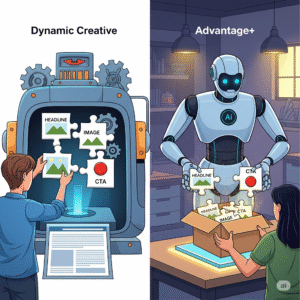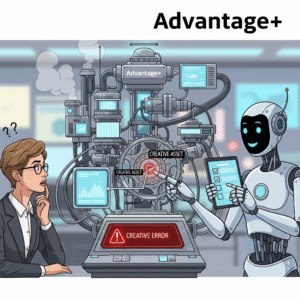So, you’ve taken the leap. You’ve launched your first Advantage+ Shopping Campaign (ASC) and handed the reins over to Meta’s powerful AI. The initial results might be promising, but a crucial question looms for every ambitious e-commerce brand: is your campaign built to truly scale? While Meta makes launching an ASC incredibly simple, the difference between mediocre results and explosive, sustainable growth often lies in a detail many advertisers overlook: the ASC structure.
Getting the underlying framework of your campaigns right is the secret to moving from basic automation to strategic, AI-powered expansion. A flawed or overly simplistic ASC structure can lead to budget misallocation, creative fatigue, and a frustrating plateau in performance. Conversely, a well-designed structure acts as a blueprint for scale, telling the AI precisely how to allocate resources to achieve your specific business goals, whether that’s aggressive customer acquisition or maximizing profitability.
This guide is for marketers who want to move beyond the default settings. We’ll dissect different ASC structure models, explore advanced budgeting strategies, and show you how to build a framework that not only performs today but is engineered for the growth of tomorrow.
Why Your ASC Structure is the Key to Unlocking Performance
Let’s be clear: the ASC structure is more than just the initial Advantage+ Shopping Campaign setup. It’s the strategic organization of your campaigns, budgets, and creative assets. It’s how you guide the AI. Think of the ASC algorithm as an incredibly talented, but new, employee. If you give them a single budget and a vague goal of “get more sales,” they’ll do a decent job. But if you provide a clear structure—”Here is the budget for our high-margin products, and here is a separate budget for international expansion”—you empower them to deliver exceptional, targeted results.
A strategic ASC structure allows you to maintain high-level control while letting the AI handle the micro-decisions. It enables you to dictate budget flow between different product lines, markets, or business objectives without getting bogged down in manually adjusting dozens of ad sets. This macro-management approach is the cornerstone of scaling e-commerce ads in the modern era, ensuring your ad spend is always aligned with your most important business priorities.
The Foundational ASC Structure: The “Consolidated” Model
The most common and simplest approach is the consolidated ASC structure. This involves running your entire advertising budget through a single, all-encompassing Advantage+ Shopping Campaign. All your products, creatives, and your entire target location are housed within this one campaign.
This model is built on the principle of maximum data consolidation. By feeding all your conversion data into one campaign, you give the machine learning algorithm the largest possible dataset to learn from, which can theoretically lead to faster learning and more efficient optimization. It’s the ultimate “set it and semi-forget it” approach, and for some businesses, it’s all they need.
Pros and Cons of this Simplified ASC Structure
- Pros: Maximum data for the algorithm, minimal management overhead, and the simplest possible setup. It’s a great starting point for new advertisers or businesses with a very straightforward product catalog.
- Cons: You have very little control over how the budget is spent across different product types or promotions. The AI will naturally favor items that convert easily (often lower-priced products), potentially underfunding your higher-margin hero products. It also makes clean creative testing for different product categories nearly impossible. This lack of control is the primary reason advertisers evolve to a more advanced ASC structure.
Advanced ASC Structure Models for Scaling
When the consolidated model’s limitations start to hinder your growth, it’s time to evolve. Advanced ASC structure models involve strategically splitting your budget into multiple ASCs, each with a distinct purpose. This gives you the control you need to scale effectively.
The “Category Split” ASC Structure
This is one of the most effective structures for brands with diverse product catalogs. In this model, you create a separate Advantage+ Shopping Campaign for each of your major product categories. For a fashion retailer, this might look like:
- ASC 1: Tops & T-Shirts
- ASC 2: Trousers & Jeans
- ASC 3: Outerwear
By implementing this ASC structure, you can assign budgets based on each category’s profitability or inventory levels. If outerwear has the highest profit margin, you can give its dedicated ASC a larger budget to ensure the AI prioritizes finding customers for those products. This prevents your high-ticket items from being ignored in favor of easier, low-value conversions.
The “Geo-Split” ASC Structure
For e-commerce businesses operating in multiple countries, the Geo-Split is essential. This ASC structure involves creating a separate ASC for each country or significant region (e.g., North America, European Union). Culture, language, pricing, and purchasing power can vary dramatically between markets, and a single campaign struggles to optimize effectively across these differences.
A Geo-Split allows you to run localized creatives (in the native language and with culturally relevant imagery), set country-specific budgets, and accurately track performance by market. It’s a non-negotiable ASC structure for any brand with international ambitions, ensuring your ads resonate with local audiences instead of feeling generic and out of place.
Real-World Success: Case Studies of Effective ASC Structure
Let’s see how these structures play out in practice.
Case Study 1: “Global Footwear Co.” – Going Global with a Geo-Split
The Challenge: A US-based sneaker brand was seeing traction in Germany and the UK but their single, consolidated ASC wasn’t delivering a strong ROAS in those markets. The campaign was dominated by US-centric creative, and the algorithm was struggling to balance optimization across three different currencies and customer behaviors.
The Solution: They adopted a Geo-Split ASC structure. They created one ASC for the USA, another for the UK, and a third for Germany. They uploaded creatives with pricing in the local currency and used ad copy translated by a native speaker.
The Result: The new structure was a game-changer. The German campaign’s ROAS improved by 90% within a month as the localized ads began to resonate. The UK campaign also saw a significant lift. This strategic ASC structure allowed them to effectively scale their international presence while maintaining strong performance in their home market.
Case Study 2: “Artisan Home Goods” – Profiting with a Category Split
The Challenge: This Shopify store sold both low-cost, high-volume items like candles and high-cost, high-margin items like handcrafted furniture. In their single ASC, the algorithm spent 80% of the budget on selling $15 candles because they converted quickly, starving the profitable furniture category of funds.
The Solution: The owner implemented a “Category Split” ASC structure. She created an “Everyday Decor” ASC for candles and small items and a “Signature Furniture” ASC with a larger, dedicated budget.
The Result: While the ROAS in the furniture campaign was technically lower, the actual profit it generated was 5x higher. This shift in ASC structure allowed the business to scale its most profitable product lines, dramatically increasing overall store profitability without a significant increase in total ad spend.
Mastering Budgeting and Prospecting vs. Retargeting in Your ASC Structure
No matter which ASC structure you choose, understanding the budget controls is paramount. The primary lever you have to manage prospecting vs. retargeting in ASC is the Existing Customer Budget Cap.
This setting tells Meta the maximum percentage of the campaign’s budget that can be spent on showing ads to your existing customers (people who have purchased before, engaged with your page, etc.).
- For Aggressive Growth: Set a low cap (e.g., 5-15%). This forces the AI to spend the vast majority of your budget finding brand-new customers, making it a powerful tool for scaling.
- For Balanced Growth & LTV: A cap between 20-30% allows for a healthy mix of new customer acquisition while still nurturing your existing base to encourage repeat purchases. As noted by marketing automation leaders at Zapier, retaining customers is often more cost-effective than acquiring new ones.
- For Sales & Promotions: During a major sale, you might temporarily increase the cap to 40-50% to ensure your loyal customers are aware of the promotion.
Proper budgeting for ASC also means giving the campaigns enough funds to exit the learning phase, which typically requires around 50 conversions per week. Underfunding your campaigns is a common mistake that prevents the AI from ever performing optimally.
The Role of Creative in a Scalable ASC Structure
Your ASC structure is the skeleton, but your creative is the lifeblood. The most brilliant structure will fail with poor or stale ads. A key part of scaling is establishing a robust creative testing system that works in harmony with your chosen structure.
Instead of throwing random ads into the machine, think in terms of “creative buckets” or themes. For example, you might test a “Social Proof” bucket (UGC, testimonials) against a “Problem/Solution” bucket (ads that highlight a customer pain point). By analyzing performance at the theme level, you gain much clearer insights. You can use AI tools to supercharge this process:
- For Creative Ideation & Copywriting: ChatGPT
- Stuck for ideas? Use ChatGPT to brainstorm angles. Prompt it with: “Act as a marketing strategist. Give me 5 creative concepts to test for a new skincare line targeting dry skin.” Use it to generate dozens of headline and text variations in minutes.
- For Deeper Performance Analysis: Power BI or Tableau
- Connect your Meta Ads and Shopify data to one of these platforms. This allows you to go beyond Meta’s dashboard and analyze which creative themes lead to the highest average order value or customer lifetime value, a concept McKinsey emphasizes as critical for long-term success.
By pairing a solid ASC structure with a data-informed creative strategy, you create a powerful, scalable system for growth.
Dynamic Creative vs Advantage+: Which AI Ad Tool Should You Use in 2025?
Conclusion: Build Your Blueprint for Growth
Advantage+ Shopping Campaigns have democratized access to powerful AI, but a “one-size-fits-all” approach will inevitably limit your potential. The true art of scaling e-commerce ads lies in building a thoughtful ASC structure that aligns with your unique business goals.
Stop letting the algorithm make every decision blindly. Take back strategic control. Analyze your product catalog, your markets, and your profitability goals. Decide if a Consolidated, Category-Split, or Geo-Split model is your best path forward. Master the nuances of the existing customer budget cap and commit to a rigorous creative testing process. By moving from a passive user to an active architect of your campaign framework, you will build an advertising engine that is truly engineered for scale.



